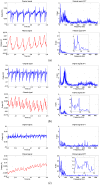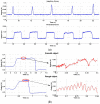A Pneumatic Tactile Sensor for Co-Operative Robots
- PMID: 29125565
- PMCID: PMC5712939
- DOI: 10.3390/s17112592
A Pneumatic Tactile Sensor for Co-Operative Robots
Abstract
Tactile sensors of comprehensive functions are urgently needed for the advanced robot to co-exist and co-operate with human beings. Pneumatic tactile sensors based on air bladder possess some noticeable advantages for human-robot interaction application. In this paper, we construct a pneumatic tactile sensor and apply it on the fingertip of robot hand to realize the sensing of force, vibration and slippage via the change of the pressure of the air bladder, and we utilize the sensor to perceive the object's features such as softness and roughness. The pneumatic tactile sensor has good linearity, repeatability and low hysteresis and both its size and sensing range can be customized by using different material as well as different thicknesses of the air bladder. It is also simple and cheap to fabricate. Therefore, the pneumatic tactile sensor is suitable for the application of co-operative robots and can be widely utilized to improve the performance of service robots. We can apply it to the fingertip of the robot to endow the robotic hand with the ability to co-operate with humans and handle the fragile objects because of the inherent compliance of the air bladder.
Keywords: force sensor; hysteresis; linearity; pneumatic tactile sensor; repeatability.
Conflict of interest statement
The authors declare no conflict of interest.
Figures













References
-
- De Oliveira T.E.A., Cretu A.-M., Da Fonseca V.P., Petriu E.M. Touch sensing for humanoid robots. IEEE Instrum. Meas. Mag. 2015;18:13–19. doi: 10.1109/MIM.2015.7271221. - DOI
-
- Yousef H., Boukallela M., Althoefer K. Tactile sensing for dexterous in-hand manipulation in robotics—A review. Sens. Actuators A Phys. 2011;167:171–187. doi: 10.1016/j.sna.2011.02.038. - DOI
-
- Zhang T., Jiang L., Wu X., Feng W., Zhou D., Liu H. Fingertip three-axis tactile sensor for multifingered grasping. IEEE/ASME Trans. Mechatron. 2015;20:1875–1885. doi: 10.1109/TMECH.2014.2357793. - DOI
-
- Silvera-Tawil D., Ryeb D., Velonaki M. Artificial skin and tactile sensing for socially interactive robots: A review. Robot. Auton. Syst. 2015;63:230–243. doi: 10.1016/j.robot.2014.09.008. - DOI
-
- Delgado A., Jarab C.A., Torres F. In-hand recognition and manipulation of elastic objects using a servo-tactile control strategy. Robot. Comput. Integr. Manuf. 2017;48:102–112. doi: 10.1016/j.rcim.2017.03.002. - DOI
MeSH terms
LinkOut - more resources
Full Text Sources
Other Literature Sources

